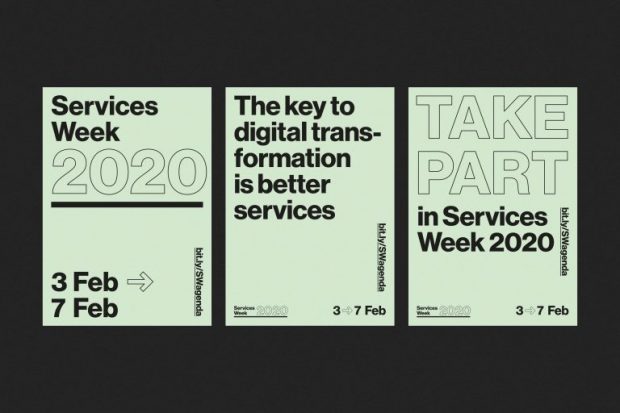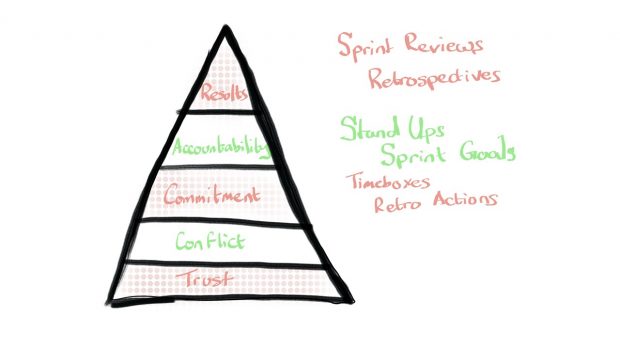Welcome to Services Week 2020, a cross-government celebration of services taking place between 3 and 7 February 2020. To help celebrate, we’re showcasing the many ways our people are working to create user-centred digital services for the UK government.

In the first article of our series of blog posts during Service Week, Agile Coach and Delivery Manager, Steve Mounsey, explores how to navigate conflict in agile teams.
Conflict in agile teams is both good and bad. Dispute sparks healthy debate and flushes out valuable insight. However, when left unchecked, conflict can destroy a team, affecting productivity, success, and satisfaction. Interpersonal skills, including empathy, listening, communication, and resiliency, are vital for digital transformation projects. Although these skills may not be as easy to measure and assess as technical skills, they’re essential to satisfactory conflict resolution.
A large part of DevOps is about teamwork. Agile teams need to collaborate, debate and agree constructively to deliver the best outcomes. It’s essential to get your points heard and to advocate your position. But an individual is not the team. Learning how to disagree productively, appreciating everyone’s view engenders trust and resolves the conflict.

Conflict or collaboration
In this age of digital transformation, organisations need to solve a lot of problems – both business and technical, to create and improve capability. According to Margaret Heffernan, many good ideas are born out of human interaction, conflict, argument, and debate. A certain degree of conflict and disagreement is necessary to achieve real innovation.
But, our problem-solving abilities can also diminish in high conflict situations. Studies indicate the cognitive load created by high conflict inhibits the thinking process to the point where we lose IQ points. For example, when members of a team anticipate a competitive hostile negotiation or high conflict, their flexibility, and creative thinking decreases. Conversely, team members become more flexible in their thinking and more creative in their approach to problem-solving when conflict is absent.
Too much discord is expensive
Conflict seething below the surface is not constructive. When left unchecked, too much strife wastes valuable time and resources. The Confederation of British Industry (CBI) estimates conflict costs UK businesses £33 billion per year, sapping up to 20 percent of leadership time, and potentially losing up to 370 million working days. The cost is not only monetary. Mental health is another aspect of conflict resolution, which can negatively impact a team’s performance and satisfaction. Continually engaging in ‘battle’ like environments take a heavy toll on an individual and team.
With the stakes so high, conflict management is a vital area that deserves attention. Getting better at disagreeing and learning how to come to a consensus more quickly means groups of individuals can collaborate, allowing them to create and deliver better solutions – faster, less expensively, and with greater satisfaction.
Conflict, trust, and psychological safety
Finding the right balance between managing conflict and reaching conflict resolution is challenging on several fronts. On the one hand, you need to have some conflict to generate new ideas. However, too much friction or conflict without resolution can destroy the team. The call to an Agile Coach and ScrumMaster is to help the team see that the appropriate level of conflict is healthy – and useful – as long as it remains constructive.
Teams that manage conflict well make bolder decisions, taking the required risks for a more exciting end. As a delivery manager and agile coach, what I do is help teams develop stronger conflict resolution skills through a range of tools and techniques. My coaching activities enable them to diffuse conflict levels before they escalate.
A predictor of high-performing teams
Lack of trust prevents groups from excelling. Google spent 2 years studying 180 teams to determine how to build the perfect team. The extensive study, Project Aristotle, found building a culture of trust and psychological safety to be the strongest predictor of high-performance teams.
Psychological safety is critical to how your team interacts. Working in an environment where conflict is feared, and artificial harmony prevails, inhibits discussion and debate. We need to feel safe to raise differences. A group stuck in a semi-agreement state will struggle to deliver their best work.
Conflict is inevitable in agile organisations
Agile organisations are low hierarchy environments. In flatter organisations where many individuals and teams are collaborating across projects, disagreements are inherent. It’s natural for teams and individuals who do things differently to express their views. However, to reach a shared outcome, individuals and teams need to collaborate – which means inevitably, conflict will arise.
Agile training doesn’t solve everything
After attending the required training course, you achieve your Scrum master certification. In those 14 hours of classroom training, you learn about the Scrum framework and how it provides antidotes to some of the dysfunctions in a team.
Your training teaches you about the value of standups, sprint reviews, and retrospectives. For example, sprint reviews show our work. Daily standups demonstrate accountability, offering teams the chance to look at the work and to inspect and adapt what is going on daily. Sprint goals identify what the group intends to achieve. Retrospectives allow teams to review what happened and to reflect on what to improve. Agile teams also use timeboxes to indicate the duration of time they are committing to completing a piece of work.
Through agile methods, a team's activities become transparent and clear. However, agile methods don't build trust or resolve conflict. Agile is great at demonstrating what a team commits to doing. But there is no agile training that teaches you how to deal with conflict, or how to build psychological safety and trust. In Patrick Lencioni's Five Dysfunctions of a Team, fear of conflict and absence of trust form the base of the Lencioni Pyramid.
 Agile practices such as sprint reviews, retrospectives, standups, timeboxes, and sprint goals address the top of Lencioni's Trust Pyramid. However, the Agile framework leaves us unprepared for the bottom.
Agile practices such as sprint reviews, retrospectives, standups, timeboxes, and sprint goals address the top of Lencioni's Trust Pyramid. However, the Agile framework leaves us unprepared for the bottom.

Minding the gap
Teams need to be able to disagree productively. A healthy measure of disagreement helps flush out better ideas. When individuals within a team can debate and discuss issues, opposing, and gaining consensus comfortably, they are likely to produce better solutions. Teams with high levels of conflict and low levels of trust will struggle to perform well. Diffusing disagreements and improving bonds within teams is fundamental to collaboration.
Agile coaching tools and techniques
The tools and techniques I use to help teams improve trust and handle conflict focus on self-reflection, empathy, and conflict diagnosis.
- Self-reflection is about holding up the mirror. Critical self-reflect in a facilitated environment gives a team the chance to explore how they are communicating and collaborating in a safe environment.
- Empathy enables team members to step into each other's shoes and understand how other people are feeling. There are different facilitation tools to help individuals develop greater understanding and insight into what their team members are feeling.
- Conflict diagnosis is the third element. There are several tools I like to use, which allow a team to self-diagnose where their conflict lies on a scale.
In my next blog posts, I will dive into the techniques I use as an Agile coach. Looking at each category – self-reflection, empathy, and conflict diagnosis, I will take you through the different methods to help dysfunctional teams build skills to improve trust and manage conflict.
Learn more
Watch out for more from Steve and other BPDTS experts by signing up to get our blog posts.
Stay up to date with what’s happening during Services Week. If you work in the public sector, take a look at the open agenda and find a session in your area that interests you.
To hear what colleagues from across government are doing, join in the conversation on social media using #ServicesWeek.
Leave a comment